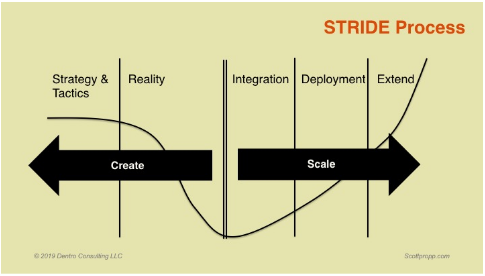
“How did my growth team miss something so big in their forecast?”
This question came up recently in a conversation with a senior growth leader. She was surprised that the team missed it and very, very unhappy that they would now need to go back to the management board for more resources.
Like a well-placed sand trap, it’s an issue that catches teams repeatedly in developing estimates for new product programs.

It’s a typical issue that emerges in the STRIDE process, specifically as we move from Integrate (I) into the Deployment (D) phase. This is the phase in the STRIDE cycle where we are going from small lot production into the full market and geographic coverage. The reason this issue is so typical is that the team is usually able to deliver the first round of projects with nearly direct support, meaning that through heroic efforts, they are able to make the client feel well supported. But when those leaders in the firm move on to the next big thing, that support becomes much more challenging to pull off.
There are always some “empty seats” in a growth program. These are the people and positions that are critical to its future success but remain stubbornly hidden during the initial phases of creating and scaling new services. Without them, it’s difficult to build a chain that delivers our product or service to the true client. Even a brilliant effort like Tesla is not immune. With electric cars requiring a very different set of specialized skills than their combustion engine twins, the well-established tiers of service providers that are currently in the community will be ill-equipped to deal with the ever-increasing demand for electric vehicles.
Tesla is just starting to become aware of the magnitude of the support that they’ll need to provide for services in the field (see articles here, here and here). The only way they are going to get there is to directly address and make sure that their products are just as amazing a year after they are delivered.
Every significant change in a product ripples through a sea of relationships and organizations and impacts them as well. So how can we anticipate these downstream changes?
- Actively build in community technical resources. When wireless was a truly emergent technology, Motorola built a well-connected channel of authorized “MSS’s” (Motorola Service Shops) in every community coast to coast. These service shops played a critical role in helping the communities source and use public safety, commercial two way, and paging systems and services. They were the secret advantage that allowed the near ubiquity of Motorola public safety systems in the latter half of the 20th century.
- Make extremely reliable products and use a parallel resource. Big automotive has a reputation for being stodgy, but they get this part right. Think about the Prius, which has a very strong reputation (I’ve ridden in multiple Ubers that have more than a quarter million miles). Their customers universally appreciate the engineering that Toyota put into the platform and the fact they can stop at any dealer and they’ll know how to help.
- Keep the first deployments very small and provide “parachute teams.” When Frank Christen (Christen Eagle) deployed his fresh approach to the Pitts Biplane, the kit was so complex that builders had some serious issues completing the planes at the quality level needed. Frank Christen did the right thing and put a team on his personal airplane to go and work with builders to get the aircrafts right and flying. Clearly, this is not an approach you can use in lower margin businesses, but since he had kept the deployment reasonable, he left himself the option of a high touch approach. This also created a very strong reputation for the brand.
It is very difficult to get these deployment issues completely worked at the ST and R stages of the project. When I work with project leaders, we take a deep dive into distribution and support issues, going over launches from other industries to get a sense of where the issues may appear.
If you are planning to launch a very fresh approach that you believe will be challenging to support, I would love to help. We can take a look at projects in other “swim lanes” and draw out some lessons and plans for your work. Please reach out by using this link. Or give me a call at (847) 651-1014.
Related posts you can benefit from…

